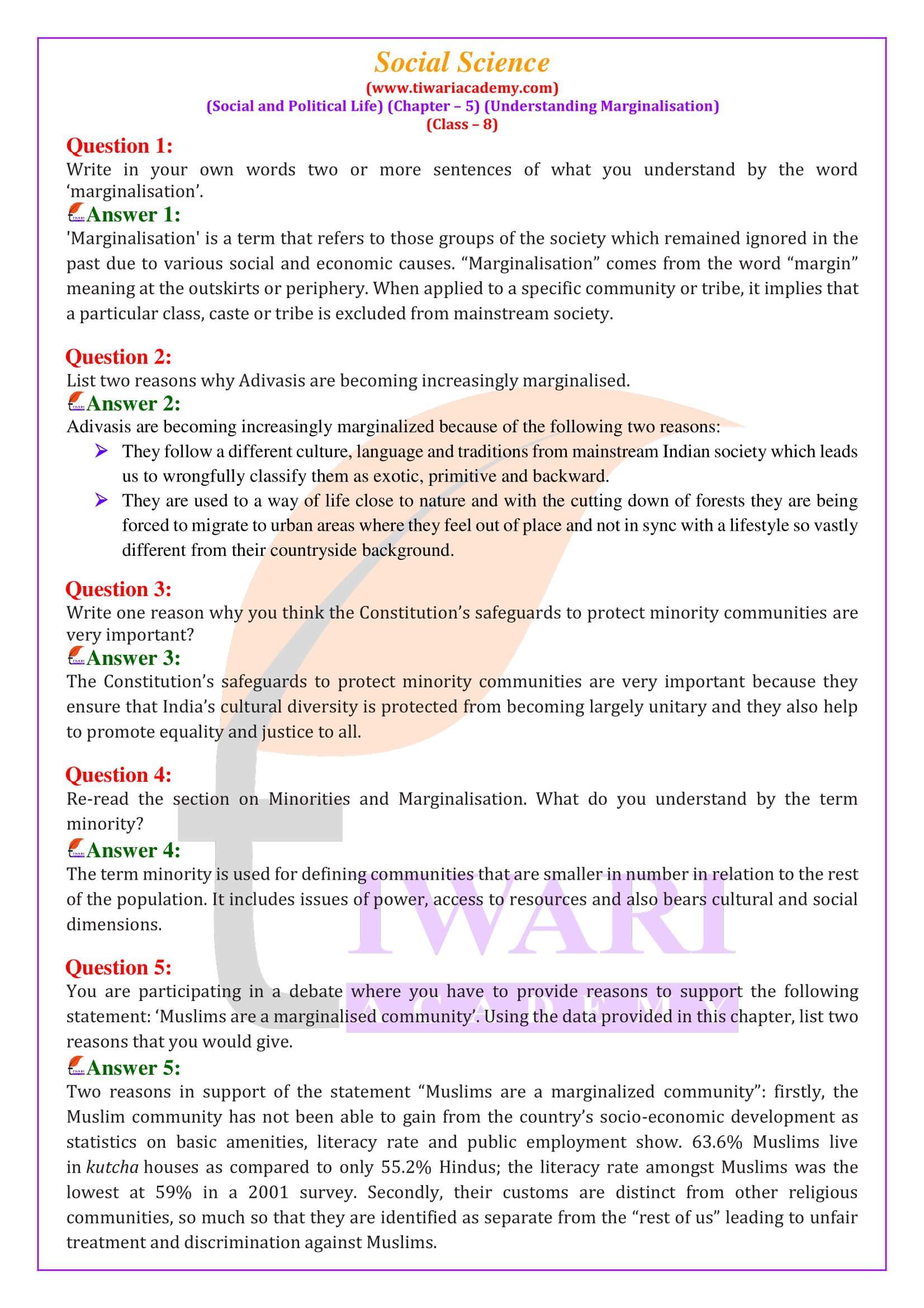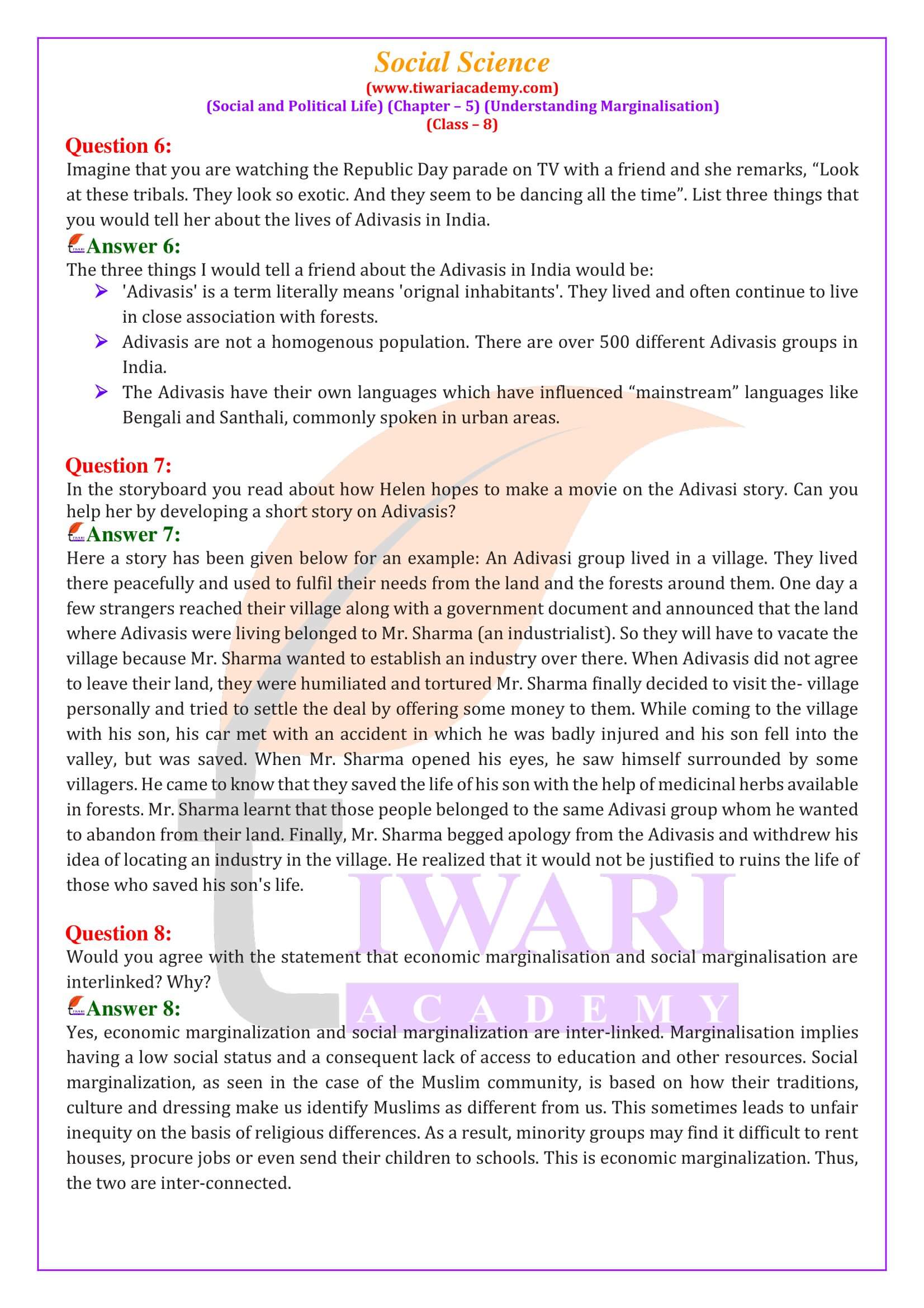NCERT Solutions for Class 8 Social Science Civics Chapter 5 Understanding Marginalisation in Hindi and English Medium (Unit 4 of Social and Political Life – III ) modified for session 2025-26. Class 8 Political Science chapter 5 Solutions are revised and updated according to rationalised NCERT books published for academic year 2025-26 CBSE and state board.
NCERT Solutions for Class 8 Social Science Civics Chapter 5
| Class: 8 | Political Science |
| Subject: | Social Science – Civics |
| Chapter 5: | Understanding Marginalisation |
| Academic Session: | 2025-26 |
Class 8 Civics Chapter 5 Question Answers
CBSE NCERT Solutions for Class 8 Social Science Civics Chapter 5 Understanding Marginalisation in PDF format. Download NCERT solutions Offline apps 2025-26 for offline use or use as it is without downloading online.
Extra Questions on 8th Civics Chapter 5
What does it mean to be Socially Marginalised?
To be marginalised is to be forced to occupy the sides or fringes and thus not be at the centre of things. Sometimes, marginalised groups are viewed with hostility and fear. This sense of difference and exclusion leads to communities not having access to resources and opportunities and in their inability to assert their rights. They experience a sense of disadvantage and powerlessness vis-a-vis more powerful and dominant sections of society who own land, are wealthy, better educated and politically powerful. Thus, marginalisation is seldom experienced in one sphere. Economic, social, cultural and political factors work together to make certain groups in society feel marginalised.
Who are Adivasis?
Adivasis – the term literally means ‘original inhabitants’ – are communities who lived, and often continue to live, in close association with forests. There are over 500 different Adivasi groups in India. Adivasis are particularly numerous in states like Chhattisgarh, Jharkhand, Madhya Pradesh, Orissa, Gujarat, Maharashtra, Rajasthan, Andhra Pradesh, West Bengal and in the north-eastern states of Arunachal Pradesh, Assam, Manipur, Meghalaya, Mizoram, Nagaland and Tripura. A state like Orissa is home to more than 60 different tribal groups.
In India, we usually ‘showcase’ Adivasi communities in particular ways. Thus, during school functions or other official events or in books and movies, Adivasis are invariably portrayed in very stereotypical ways – in colourful costumes, headgear and through their dancing. Besides this, we seem to know very little about the realities of their lives. This often wrongly leads to people believing that they are exotic, primitive and backward. Often Adivasis are blamed for their lack of advancement as they are believed to be resistant to change or new ideas.
Important Notes on 8th Civics Chapter 7
Adivasi societies are also most distinctive because there is often very little hierarchy among them. Adivasis practise a range of tribal religions that are different from Islam, Hinduism and Christianity.
These often involve the worship of ancestors, village and nature spirits, the last associated with and residing in various sites in the landscape – ‘mountain-spirits’, ‘river-spirits’, ‘animal-spirits’, etc.
The village spirits are often worshipped at specific sacred groves within the village boundary while the ancestral ones are usually worshipped at home. Additionally, Adivasis have always been influenced by different surrounding religions like Shakta, Buddhist, Vaishnav, Bhakti and Christianity.
Important Questions on 8th Civics Chapter 5
Write in your own words two or more sentences of what you understand by the word ‘marginalisation’.
‘Marginalisation’ is a term that refers to those groups of the society which remained ignored in the past due to various social and economic causes. “Marginalisation” comes from the word “margin” meaning at the outskirts or periphery. When applied to a specific community or tribe, it implies that a particular class, caste or tribe is excluded from mainstream society.
List two reasons why Adivasis are becoming increasingly marginalised.
Adivasis are becoming increasingly marginalized because of the following two reasons: They follow a different culture, language and traditions from mainstream Indian society which leads us to wrongfully classify them as exotic, primitive and backward. They are used to a way of life close to nature and with the cutting down of forests they are being forced to migrate to urban areas where they feel out of place and not in sync with a lifestyle so vastly different from their countryside background.
Write one reason why you think the Constitution’s safeguards to protect minority communities are very important?
The Constitution’s safeguards to protect minority communities are very important because they ensure that India’s cultural diversity is protected from becoming largely unitary and they also help to promote equality and justice to all.
Re-read the section on Minorities and Marginalisation. What do you understand by the term minority?
The term minority is used for defining communities that are smaller in number in relation to the rest of the population. It includes issues of power, access to resources and also bears cultural and social dimensions.
You are participating in a debate where you have to provide reasons to support the following statement: ‘Muslims are a marginalised community’. Using the data provided in this chapter, list two reasons that you would give.
Two reasons in support of the statement “Muslims are a marginalized community”: firstly, the Muslim community has not been able to gain from the country’s socio-economic development as statistics on basic amenities, literacy rate and public employment show. 63.6% Muslims live in kutcha houses as compared to only 55.2% Hindus; the literacy rate amongst Muslims was the lowest at 59% in a 2001 survey. Secondly, their customs are distinct from other religious communities, so much so that they are identified as separate from the “rest of us” leading to unfair treatment and discrimination against Muslims.
Imagine that you are watching the Republic Day parade on TV with a friend and she remarks, “Look at these tribals. They look so exotic. And they seem to be dancing all the time”. List three things that you would tell her about the lives of Adivasis in India.
The three things I would tell a friend about the Adivasis in India would be: ‘Adivasis’ is a term literally means ‘orignal inhabitants’. They lived and often continue to live in close association with forests. Adivasis are not a homogenous population. There are over 500 different Adivasis groups in India. The Adivasis have their own languages which have influenced “mainstream” languages like Bengali and Santhali, commonly spoken in urban areas.
In the storyboard you read about how Helen hopes to make a movie on the Adivasi story. Can you help her by developing a short story on Adivasis?
Here a story has been given below for an example: An Adivasi group lived in a village. They lived there peacefully and used to fulfil their needs from the land and the forests around them. One day a few strangers reached their village along with a government document and announced that the land where Adivasis were living belonged to Mr. Sharma (an industrialist). So they will have to vacate the village because Mr. Sharma wanted to establish an industry over there. When Adivasis did not agree to leave their land, they were humiliated and tortured Mr. Sharma finally decided to visit the- village personally and tried to settle the deal by offering some money to them. While coming to the village with his son, his car met with an accident in which he was badly injured and his son fell into the valley, but was saved.When Mr. Sharma opened his eyes, he saw himself surrounded by some villagers. He came to know that they saved the life of his son with the help of medicinal herbs available in forests. Mr. Sharma learnt that those people belonged to the same Adivasi group whom he wanted to abandon from their land.Finally, Mr. Sharma begged apology from the Adivasis and withdrew his idea of locating an industry in the village. He realized that it would not be justified to ruins the life of those who saved his son’s life.
Yes, economic marginalization and social marginalization are inter-linked. Marginalisation implies having a low social status and a consequent lack of access to education and other resources. Social marginalization, as seen in the case of the Muslim community, is based on how their traditions, culture and dressing make us identify Muslims as different from us. This sometimes leads to unfair inequity on the basis of religious differences. As a result, minority groups may find it difficult to rent houses, procure jobs or even send their children to schools. This is economic marginalization. Thus, the two are inter-connected.





